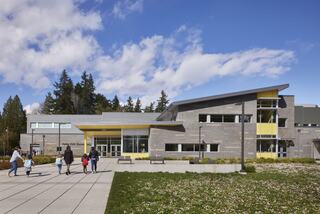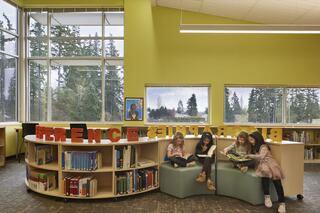It’s All About the Kids — Stories from an Operational Campus Project

While it carries its own special logistical challenges, there’s something uniquely rewarding about working on a site that is busy day-to-day with the kids who get to learn and grow in the schools we’re building. This is one of the main reasons why K-12 projects are particularly special for our Lewis teams.
I got to sit down with some of the project team members on the Peter Kirk and Margaret Mead elementary school replacement projects to hear a little more about the challenges and rewards of our K-12 market sector. Their stories about how they navigated construction on operational elementary school campuses are heartwarming and compelling.
While it carries its own special logistical challenges, there’s something uniquely rewarding about working on a site that is busy day-to-day with the kids who get to learn and grow in the schools we’re building. This is one of the main reasons why K-12 projects are particularly special for our Lewis teams.
I got to sit down with some of the project team members on the Peter Kirk and Margaret Mead elementary school replacement projects to hear a little more about the challenges and rewards of our K-12 market sector. Their stories about how they navigated construction on operational elementary school campuses are heartwarming and compelling.
The Kids Come First
Safety
While Eric Holzer was working as Project Manager on Margaret Mead Elementary and Peter Kirk Elementary, he and his team placed a special emphasis on the safety of the site and its surroundings during the projects. Every day started with a typical Lewis safety huddle that reiterated their focus on the safety of the children as well as the importance of being respectful guests on the campus.
“Keep the kids safe, look out for them, keep your language in check, be good stewards of the school district,” he repeated, recalling the daily reminder. His easy recollection told me how well this point was driven home and the team truly championed it.
Security
Site fencing had to be extra protective and kid-proof.
Young kids are drawn to construction sites and want to know how all the equipment works and what the construction process is like. Most recesses, they’re glued to the fence, peering through the gaps to see what’s going on. Many of the Lewis team members working on the schools had young children of their own, so they approached these projects from both a construction perspective as well as a parental one, knowing all too well that when kids are small and still learning, they’ll try to crawl under and over anything they can.
Early in the project, one of the project team members even came to the site with her two young kids to test out the specialty fencing they built and make sure that even the smallest of kids couldn’t wiggle their way through. As part of added protection of the site, the Lewis team placed added barriers at the bottoms of the fencing to close the natural gaps in the fence panels to prevent the children from crawling under.
Communication
A key element of safety on an operational campus is constant communication. On both Kirk and Mead, Holzer had a direct line of contact to the principals of each school and “the communication went both ways,” he said.
Our team gave project updates to the district and they warned us of events that would happen outside of normal hours, such as parent-teacher conferences or half days. To ensure that the work didn’t impact students or school functionality, the team limited deliveries during peak traffic hours like pick up and drop off and planned construction schedules around school events.

Peter Kirk Elementary School, Lake Washington School District © Copyright 2022 Benjamin Benschneider
Leading by Example
Kids have a natural element of curiosity and love to know more about the construction process. It was important to consider them and their continuous curiosity throughout the project. When the team put up the temporary fencing, they made sure to include safe opportunities to see the construction site instead of blocking it from view. They constructed small viewing spaces made from plexiglass and plywood that kids could see the construction work happen from while at recess.
Keith Shafer, the Superintendent on both projects, recalled one of his favorite moments working on Peter Kirk and Margaret Mead. In partnership with the school, the team was invited to teach several classrooms about the construction process and the importance of safety. While Eric Holzer, Site Safety Coordinator Chilly Hiliker and Superintendent Justin Grindol were explaining how Lewis was turning a pile of dirt into their future school in the classroom, Keith was working behind the scenes orchestrating a whole construction equipment parade for them.
“I remember the team got really into the classroom demonstrations,” he recalled with a smile. “When they came out to show the classes the site, I had a bunch of our crew members drive the equipment by the viewing spot the so the students could see all the big construction trucks from the site — it was a huge hit with the kids.” He even got the dirt contractor to drive the dirt excavating equipment by for them to see. According to Keith and the rest of the project team, it was the water truck, taking up the rear of the equipment parade, that stole the show.
“On top of keeping kids safe, we knew that this was also a learning environment for them and wanted to make sure they stayed curious. Kids are the builders of the future, so it was both important and fun for us to keep them curious.”
— Keith Shafer, Superintendent
Tackling The Logistics
One of the biggest challenges of working on an occupied campus that is unique to the K-12 sector is the careful logistics and sequencing of the project. Our teams must look at how to plan around the existing site, the construction schedule and the schedule of the current and future students and faculty.
Both the Peter Kirk and Margaret Mead projects were guided by thoughtful and careful planning and phasing. Lewis was engaged early to provide comprehensive constructability feedback and address the complexities of building on the occupied site. With Peter Kirk, the challenge came in keeping the new building as close as possible to the old one to prevent major investments to changing the topography and landscape of the campus. In the end, the new school was built a mere 10 feet and 11 inches away from the existing, occupied building. In a highly collaborative and in-depth effort, Lewis worked closely with the architects Studio Meng Strazzara and Lake Washington School District to figure out the best design that would be most efficient, cost effective and meet the needs of the school district.
When working on elementary school replacement projects, Lewis teams determine the dual critical paths that will define the project schedule:
- Build the building as quickly and efficiently as we can in order to turn it over for teacher move in and training.
- The demolition of the old school can’t happen until school is out so the project must meet the school’s summer schedule deadline.
When building around a school schedule, there is a very specific window to minimize impact to the students and complete the project on time. Summer break is only ten weeks long, teachers are given two weeks to move everything out and into the new building and demolition usually takes about six weeks.
Any change or delay in the schedule prior to the summer break affects that tight window—so attention to detail, planning and risk management is a top priority.
“I get to turn over this building to a community and see the impact first-hand. From the moment that ribbon is cut, I know the work we do is going to have a lasting impact on generations of kids to come.”
— Eric Holzer, Lewis Project Manager
The Fulfillment of K-12 Work
“There’s nothing like the pure joy of turning over an elementary school and getting to see the kids run in on that first day,” Eric explained. It’s a sentiment that was echoed by both project teams.
During turnover, K-12 projects receive particular fanfare. At the grand opening celebrations for Peter Kirk and Margaret Mead, the whole community showed up to see the new schools. The gratitude the crew received from the community was truly special.
At the end of the project, it’s not just an empty shell of a building that is waiting for a tenant, it is something more than that. The new schools are full of spaces and features that these kids and staff didn’t have before. It’s natural light, better technology and workspaces, operable doors for combined teaching and flexible teaching spaces. It’s a cafeteria where students can build important friendships over lunch, a commons space where they can perform in the school play and a gymnasium where they’ll score winning baskets in gym class.

Peter Kirk Elementary School, Lake Washington School District © Copyright 2022 Benjamin Benschneider